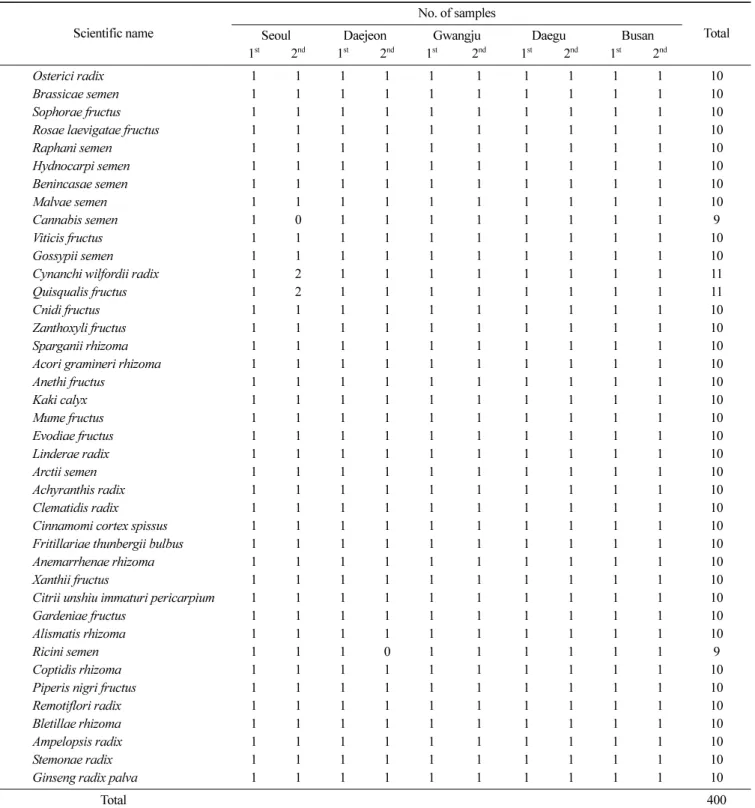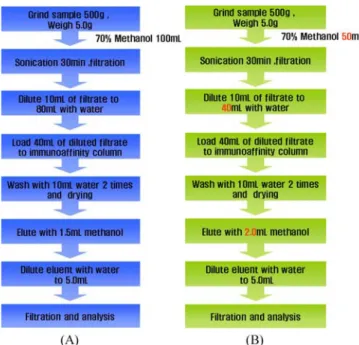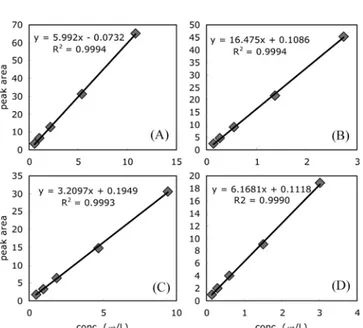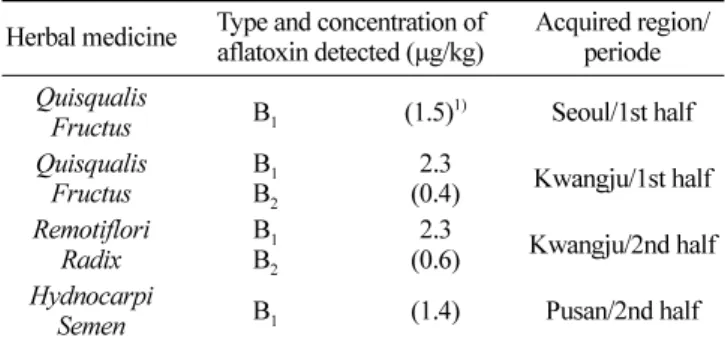27
©The Korean Society of Food Science and Technology
유통 생약재의 아플라톡신 모니터링
김용훈*·강한샘·오선우·이화정1·김미경1·정소영·최선희·방수진·한경진·
이지원·김영선·김희연
서울지방식품의약품안전청, 1식품의약품안전청
Monitoring of Aflatoxins in Medicinal Herbs
Yong-Hoon Kim*, Han-Saem Kang, Sun-Woo Oh, Hwa-Jung Lee1, Mi-Gyeong Kim1, So-Young Chung, Seon-Hee Choi,
Su-Jin Bang, Kyung-Jin Han, Ji-Won Lee, Young-Seon Kim, and Hee-Yun Kim
Seoul Regional Korea Food and Drug Administration
1Korea Food and Drug Administration
Abstract This study was conducted to monitor aflatoxins in various medicinal herbs, providing available data for the
safety of those products. To monitor aflatoxins in medicinal herbs, a total of 400 samples of 40 different herbs were collected in commercial retailers in Seoul, Daejeon, Gwangju, Daegu, and Busan from March to August, 2008. The samples that passed the sensory evaluation were tested for aflatoxins. Aflatoxins in samples were analyzed by HPLC-florescence coupled with photochemical enhancement. Samples were extracted with 70% methanol and then diluted to the appropriate concentration. A refining process was performed using an immunoaffinity column. The analytical method used in this study was validated. The R2 value for aflatoxin B
1 was 0.99946, and the detection range was from 0.25 to 10.0
ng/mL. The accuracy of the analysis was ranged from 83.2% to 101.8%. The relative standard deviation (RSD) in the aflatoxin B1 analysis was 3.4%, demonstrating the precision of this method. In addition, the detection limit and quantitative
analysis limit of aflatoxin B1 was 0.53µg/kg and 1.76µg/kg, respectively. These results indicated that the analytical
method used in this study was appropriate. The results of HPLC showed that 1% (4 samples) of the samples may contain aflatoxins. The concentration of quantified aflatoxin was 2.3µg/kg for both Quisqualis fructus and Remotiflori radix
samples. The other samples were below the limit of quantification. Moreover, the concentration of aflatoxin B1 which is
made by specific fungi were below the level of regulation. Only 20% of aflatoxin B1 were transferred to hot water.
Therefore, the levels of aflatoxins in medicinal herbs were considered to be safe especially considering the aflatoxin transfer ratio.
Key words: aflatoxin, medicinal herb, mycotoxin
서 론 식물, 동물, 광물의천연산물을그대로또는 가공하여사용하는 생약의안전성관리가중요한과제로대두되고있다. 그동안일반 적으로생약의안전성은잔류농약, 이산화황및중금속오염여부 등을중심으로관리하여왔으나최근에는생약에오염된곰팡이 독소(mycotoxin) 잔류여부가생약의중요한안전성의지표로거론 되고있다. 그중아플라톡신은간에직접적인영향을미쳐간암 을유발시키는것으로곰팡이독소중에서가장발암력이강한것 으로알려져있다. 곰팡이독소중아플라톡신은식품및농산물과 관련하여인간과가축에게가장치명적인독성을나타내는곰팡 이독소로서Aspergillus spp. 곰팡이에의해생성되며대표적인균
주로는 A. flavus, A. parasiticus, A. nomius, A. bombycis, A.
ochraceoroseus, A. pseudotamari 등이알려져 있다. 아플라톡신은 주로 고온다습한열대나아열대지방에서잘생성되며수확에서 건조까지저장기간이길고, 환기가 불충분할수록잘생성된다. 특 히, 농산물중에서는쌀, 보리, 밀등의곡류와땅콩, 파스타치오, 호두와같은견과류, 옥수수등과같이탄수화물함량이높은기 질에서잘생성되는것으로알려져있다. 아플라톡신은아플라톡 신 B1, B2, G1, G2, M1, M2 등이대표적이며현재까지약 20종의 이성체가알려져 있다(1). 이들은무색에서연노랑색의 결정체로 자외선하에서나타내는형광의색에따라 B(blue)군, G(green)군 으로 구분되며동물의소변과 우유에서발견되는 M(metabolized) 군은 대사물질로서청자색(blue-violet) 형광을나타낸다(2,3). 세계각국에서는가장독성이강한것으로알려진아플라톡신 B1에대해서는 0-30 ppb, 총아플라톡신에대해서는 0-50 ppb로규 제하고있는것으로밝히고있다(3). 우리나라에서는 아플라톡신 B1, B2, G1, G2의총합으로서 15 ppb 이하 특히 B1은 10 ppb이하 로규제하고있다. 한편우리나라의 기후조건은아플라톡신 생 성에 최적이라고할수는없으나, 외국으로부터의농산물과 사료 용곡물의수입량이증가하고, 국민의대부분이곡류 및곡류 가 공식품을 주식으로하기 때문에 aflatoxin에 노출될가능성이 높 을것으로예상된다. 생약의 경우 유럽연합에서는아플라톡신 B1 5 ppb, 총아플라
*Corresponding author: Yong-Hoon Kim, Seoul Regional Korea Food and Drug Administration, Seoul 158-050, Korea
Tel: 82-2-2640-1463 Fax: 82-2-2640-1364
E-mail: washout71@kfda.go.kr
톡신 10 ppb를기준으로정하여관리하고있으며, 국내에서는지 난 2009년 6월생약등의 잔류오염물질기준 및시험방법이 개 정되어감초, 결명자, 도인, 반하, 백자인, 빈랑, 산조인, 원지, 홍 화등 19품목에대하여아플라톡신 B1 10 ppb 이하의규격을적 용하여시행하고있다. 생약(한약)재의종류가 500종이상임을감 안할때점차 지속적인모니터링을 통하여 아플라톡신 오염우 려가있는생약품목을확대하고현고시의시험법에관한보다 과학적인검증자료를확보하고자 하였다. 재료 및 방법 실험재료 서울, 대전, 대구, 광주, 부산 5개지역에서, 상반기(1차, 3-6월) 와하반기(2차, 7-9월) 두번에 나누어구입하였다. 각지역별로 강활, 개자, 괴각, 금앵자, 내복자, 대풍자, 동과자, 동규자, 만형 자, 면실자 등 40종으로 총 400건에대하여분석하였다. 다빈도 한약 100종중 Chung 등(2), Shim 등(3)의연구에서조사한품목
Table 1. List of herbal medicines for the monitoring of aflatoxins
Scientific name Seoul Daejeon No. of samplesGwangju Daegu Busan Total
1st 2nd 1st 2nd 1st 2nd 1st 2nd 1st 2nd
Osterici radix 1 1 1 1 1 1 1 1 1 1 10
Brassicae semen 1 1 1 1 1 1 1 1 1 1 10
Sophorae fructus 1 1 1 1 1 1 1 1 1 1 10
Rosae laevigatae fructus 1 1 1 1 1 1 1 1 1 1 10
Raphani semen 1 1 1 1 1 1 1 1 1 1 10 Hydnocarpi semen 1 1 1 1 1 1 1 1 1 1 10 Benincasae semen 1 1 1 1 1 1 1 1 1 1 10 Malvae semen 1 1 1 1 1 1 1 1 1 1 10 Cannabis semen 1 0 1 1 1 1 1 1 1 1 9 Viticis fructus 1 1 1 1 1 1 1 1 1 1 10 Gossypii semen 1 1 1 1 1 1 1 1 1 1 10
Cynanchi wilfordii radix 1 2 1 1 1 1 1 1 1 1 11
Quisqualis fructus 1 2 1 1 1 1 1 1 1 1 11
Cnidi fructus 1 1 1 1 1 1 1 1 1 1 10
Zanthoxyli fructus 1 1 1 1 1 1 1 1 1 1 10
Sparganii rhizoma 1 1 1 1 1 1 1 1 1 1 10
Acori gramineri rhizoma 1 1 1 1 1 1 1 1 1 1 10
Anethi fructus 1 1 1 1 1 1 1 1 1 1 10 Kaki calyx 1 1 1 1 1 1 1 1 1 1 10 Mume fructus 1 1 1 1 1 1 1 1 1 1 10 Evodiae fructus 1 1 1 1 1 1 1 1 1 1 10 Linderae radix 1 1 1 1 1 1 1 1 1 1 10 Arctii semen 1 1 1 1 1 1 1 1 1 1 10 Achyranthis radix 1 1 1 1 1 1 1 1 1 1 10 Clematidis radix 1 1 1 1 1 1 1 1 1 1 10
Cinnamomi cortex spissus 1 1 1 1 1 1 1 1 1 1 10
Fritillariae thunbergii bulbus 1 1 1 1 1 1 1 1 1 1 10
Anemarrhenae rhizoma 1 1 1 1 1 1 1 1 1 1 10
Xanthii fructus 1 1 1 1 1 1 1 1 1 1 10
Citrii unshiu immaturi pericarpium 1 1 1 1 1 1 1 1 1 1 10
Gardeniae fructus 1 1 1 1 1 1 1 1 1 1 10
Alismatis rhizoma 1 1 1 1 1 1 1 1 1 1 10
Ricini semen 1 1 1 0 1 1 1 1 1 1 9
Coptidis rhizoma 1 1 1 1 1 1 1 1 1 1 10
Piperis nigri fructus 1 1 1 1 1 1 1 1 1 1 10
Remotiflori radix 1 1 1 1 1 1 1 1 1 1 10
Bletillae rhizoma 1 1 1 1 1 1 1 1 1 1 10
Ampelopsis radix 1 1 1 1 1 1 1 1 1 1 10
Stemonae radix 1 1 1 1 1 1 1 1 1 1 10
Ginseng radix palva 1 1 1 1 1 1 1 1 1 1 10
을제외하고, 동남아수입여부, 생약형태등을고려하여미생물 및아플라톡신오염우려가높은종자생약을우선 선정하였다. 대상검체의목록은 Table 1과같다. 구입한검체중관능검사를 통과한진품에대해서만실험을수행하였다. 표준품 및 시약 아플라톡신 표준품은 B1, B2, G1, G2의 혼합표준품(Supelco,
Bellefonte, PA, USA)을 사용하였으며, 아세토니트릴(Burdick &
Jackson, Muskegon, MI, USA), 메탄올(Burdick & Jackson)은
HPLC grade급을 사용하였다. 시료 정제에는 Afla Test WB
(VICAM, Milford, MA, USA)를사용하였다. 시료 전처리 면역친화성 정제칼럼을 사용하는 식품의약품안전청에서 고시 한방법(식품의약품안전청 고시제2008-4호)된 시험법을 기초로 시험법을확립하였다. 전처리 방법을 Fig. 1에도시하였다. 아플 라톡신추출용매량, 전처리시희석배율과 정제과정 중용출용매 의양을변경하여 전처리에 의해과도하게 희석되는 점을개선 하였다(2-10). 분석조건 전처리된시료를 액체크로마토그래프법으로분석하였다. 분석 조건은식품의약품안전청에서고시한방법을그대로사용하였다.
Agilent 1100 HPLC(Palo Alto, CA, USA)를 사용하였으며, 검출 기는형광검출기(여기파장: 365 nm, 형광파장: 435 nm)를사용하
였다. 후칼럼 유도체화 장치는 광화학 반응장치 PHRED(AURA
industries, New York, NY, USA)를 사용하였다. 칼럼은 Capcell
pak C18 UG120(4.6×250 mm, 5µm, Shiseido, Tokyo, Japan)를 사용하고이동상은아세토니트릴:메탄올:물(2:3:6)을 0.9 mL/분의
유속으로 분석하였으며 주입량은 50µL였다. Mass
spectrome-ter(MS)를 사용한 분석조건은 HPLC는 Nanospace SI-2(Shiseido) 를 MS/MS 검출기는 TSQ Quantum Discovery Max(Thermo
Electron Co., Waltham, MA, USA)을 이용하였다. Column은
Cadenza 5CD-C18(150×2 mm, 5µm, Imtakt, Kyoto, Japan)를사용 하였으며 이동상은 0.1% formic acid(A)와 formic acid를아세토
Fig. 1. Aflatoxin sample preparation method using immunoaffinity column. A: Origial method from the notification of KFDA. B: The modified method
Fig. 2. Chromatogram of aflatoxin standard using HPLC-FLD detector.
Fig. 3. LC/MS/MS chromatogram of aflatoxin standards. A, aflatoxin B1; B, aflatoxin B2; C, aflatoxin G1; D, aflatoxin G2
Table 2. HPLC-MS/MS parameters for analysis of aflatoxins
Compound Q1 mass(amu) Q3 mass(amu) Collision energy (eV)
Aflatoxin B1 313 241.1269 3535
Aflatoxin B2 315 287.1259 2525
Aflatoxin G1 329 242.9310.8 2525
니트릴에 0.1% 되도록 녹인이동상(B)을 gradient로 분석하였다. gradient 조건은 초기 %B 20%, 4분 %B 60%, 8분 %B 90%, 12분 %B 90%, 15분 %B 20%로하였으며유속은 0.3 mL/min 이 었다. 주입량은 10µL였다. MS/MS 조건은 Table 2와같다(11-13). 형광검출기와 MS/MS 검출기를사용한표준품 분석크로마토그 램은 Fig. 2 및 Fig. 3과같다. 탕제로의 이행률 생약섭취모델중 탕제를통한아플라톡신의 이행률을 알아 보기위한 실험을수행하였다. 실험에사용하기에 적합한농도로 아플라톡신이 검출된검체가 없어사군자(Quisqualis fructus), 제 니(Remotiflori radix) 및시라자(Anethi fructus)의음성시료에아플
라톡신을첨가하여실험을수행하였다. 각생약약 300 g씩을분 쇄하여 100 g을비커에칭량하였다. 아플라톡신 B1기준으로 10µg/ kg가되도록 spiking한뒤냉암소에서 1시간동안방치하여아플 라톡신이조직내부에침투하도록하였다. 증류수 1000 mL을첨 가한후엑스제의 제법에따라약탕기를사용하여 80-100oC (평 균 95oC)에서 2시간 30분동안추출하였다. 추출이끝난 후추출 액을 1000 mL로 정용한 후 그 중 10 mL을 면역친화성 칼럼에 loading 한후 동일한조작으로 정제 후분석하였다. 각 실험은 2 반복으로 수행하였으며 회수율 보정을 위해 각 sample 마다 70% 메탄올로추출한회수율실험구를하나씩병행하여실험하였다. 결과 및 고찰 시험법 유효화 식품의약품안전청에서고시한시험법을기초로변경한시험법 의유효화를실시하였다. 아플라톡신혼합표준품을 50% 메탄올 로희석하여 아플라톡신 B1 기준으로 0.51, 1.02, 2.04, 5.1, 10.2 µg/L의농도가 되도록 희석하여 분석용 표준용액으로 사용하여 직선성을확인하였다(Fig. 4). 실험은 3 반복을 실시하였다. 검출 한계와정량한계는 signal-to-noise 비율을이용하여검출한계와정 량한계를계산하였다(Table 2). 아플라톡신 B1의경우정량한계가 0.35µg/L로전처리로인해 5배희석되는것을감안하면약 1.8µg/ kg 수준의 아플라톡신 B1을정량할수있는것으로나타났다. 아 플라톡신 분석에 선택성이 뛰어난 형광검출기를 사용하였을 뿐 만아니라정제과정에서도아플라톡신에특이적으로반응하는면 역친화성칼럼을사용하여서특이성및선택성은매우우수하였 다. 다만강활의경우 시료자체에 의한간섭으로분석에 어려움 이있어 LC/MS/MS를이용하여분석하는것이적합하였다. 정확성 및 정밀성 실험을 위해 개자(Brassicae semen), 마인
(Cammabis semen), 청피(Citrii unshiu immaturi pericarpium)에
아플라톡신을 첨가한후전처리를거쳐분석하였다. 각실험구는 3 반복으로실험하였다. 각각의검체약 5 g에아플라톡신 B1 기 준으로 100µg/L 농도의표준품을 0.25, 0.50, 1.0 mL 첨가하여아 플라톡신 B1기준으로 5, 10, 20µg/kg이되도록첨가하였다(아플 라톡신 B1:B2:G1:G2 농도비=1:0.28:0.88:0.25). 아플라톡신 첨가 후 냉암소에서 1시간동안 방치하여 첨가한아플라톡신이 조직 내부로 침투하도록하였다. 그후전술한전처리방법과 분석법으 로아플라톡신을분석하였다(Table 3). 아플라톡신 B1에대해서는 각첨가농도에서 83.2%에서 101.8%의회수율을보였다. 최소 80% 이상의 회수율을보여 data의신뢰도가높았으며, data 간의 편차
(relative standard deviation, RSD) 또한 3.4% 이하로정밀성또한
Fig. 4. Standard curves for aflatoxins. A, aflatoxin B1; B, aflatoxin
B2; C, aflatoxin G1; D, aflatoxin G2
Table 3. Limit of detection (LOD) and limit of quantification (LOQ) of aflatoxins
Compound Concentration of aflatoxin used (µg/L)
Signal/
Noise (µLODg/kg) (µLOQg/kg)
Aflatoxin B1 0.510 14.5 0.53 1.76
Aflatoxin B2 0.166 13.6 0.18 0.61
Aflatoxin G1 0.505 7.4 1.02 3.41
Aflatoxin G2 0.138 5.5 0.38 1.25
Fig. 5. Chromatograms of aflatoxins detected using fluorescence detector.
만족하여분석에적합한 것으로나타났다. 아플라톡신 B2와 G1의 경우에도 높은회수율을 보였으며정밀성 또한만족할 만한수 준이었다. 하지만아플라톡신 G2의경우회수율도낮을뿐아니 라정밀성도매우떨어지는결과를 보였다. 정제에사용된면역 친화성칼럼이 아플라톡신 B1에맞춰 설계되어다른 종류의아 플라톡신, 특히 G2에대해서는특이적으로 결합하지못해이러한 결과를보인것으로사료된다(14,15). 아플라톡신 모니터링 결과 구입한 400건의검체를 유효화과정을 거친개선된 방법으로 아플라톡신을검사하였다. 대부분의검체에서아플라톡신이검출 되지않아검출된검체만을 Table 5에나열하였다. 종자생약인대 풍자(Hydnocarpi semen)와열매생약인 사군자(Quisqualis fructus)
에서각각 1건과 2건이검출되었으며제니(Remotiflori radix)에서 1건검출되었다. 검출된양은 모두 2.5µg/kg 이하의극미량이었 다. 사군자 1건과제니 1건에서각각아플라톡신 B1이 2.3µg/kg 가검출되었으며(Fig. 5) 사군자 1건과대풍자에서는정량한계미 만의아플라톡신이검출되었다. 정량한계이상으로아플라톡신이 검출된경우가 2건밖에없어지역별, 시기별차이에대한자료 를얻을수 없었다. 아플라톡신 관리기준이 10µg/kg인 것에비 해볼때검출된사례의수와농도가매우낮아생약은아플라톡 신으로부터안전하다고 판단되었다. 하지만아플라톡신이 강한 독성을갖고 있으므로지속적인관리가필요할것으로사료된다. 아플라톡신 이행률 결과 70% 메탄올로추출한실험구에대한상대적인아플라톡신 검 출량은 Table 6와같다. 아플라톡신 B1의경우약 20% 정도의이 행률을 나타냈다. 생약은 주로탕제의 형식으로섭취하므로 아플 라톡신에 오염된 생약이라도 일부만이 이행되어 직접 섭취하는 경우에 비해 안전할 것으로 생각된다. 하지만 탕제로 섭취하는 경우에도 이행이전혀 되지않는 것이아니며 아플라톡신의 강 한독성을 감안한다면 안전하다고 할수없어 생약의안전관리 에반드시고려해야할사항이다. 요 약 고시된아플라톡신 시험법의정량한계, 검출한계를개선한 분 석법을 유효화하였으며, 개선한 분석법으로 강활, 개자등의 생 약 400개의시료를분석하였다. 사군자와제니각 1건에서아플 라톡신 B1이각 2.3µg/kg 검출되었으며, 사군자와 대풍자 1건에 서정량한계 미만의아플라톡신이 검출되었다. 탕제로의이행률 은아플라톡신 B1의경우약 20% 정도의이행률을나타냈다. 아 플라톡신 B1 기준치보다 낮게 검출되어 현재까지는 아플라톡신 으로부터안전한 것으로판단되었다. 문 헌
1. Bacaloni A, Cavaliere C, Cucci F, Foglia P, Samperi R, Lagana A. Determination of aflatoxins in hazelnuts by various sample preparation methods and liquid chromatography-tandem mass
Table 4. Recovery of aflatoxins in various herbal medicines
Herbal medicine Concentration of aflatoxin added (as aflatoxin B1)1)
Recovery (RSD)
Aflatoxin B1 Aflatoxin B2 Aflatoxin G1 Aflatoxin G2
Brassicae Semen 5 µg/kg 94.3%(1.5%) 105.2%(6.6%) 113.2%(6.4%) 50.6%(3.3%) 10 µg/kg 91.9%(1.4%) 104.4%(2.9%) 108.6%(3.7%) 55.6%(4.9%) 20 µg/kg 88.3%(2.4%) 95.5%(5.5%) 105.8%(9.7%) 58.3%(23.4%) average 91.5%(3.3%) 101.7%(6.5%) 109.2%(6.8%) 54.8%(14.2%) Cannabis Semen 5 µg/kg 85.1%(4.0%) 90.8%(2.4%) 95.2%(2.9%) 64.5%(14.1%) 10 µg/kg 85.8%(3.6%) 91.2%(1.9%) 96.6%(2.3%) 67.9%(9.8%) 20 µg/kg 83.2%(3.2%) 94.6%(7.5%) 115.4%(14.2%) 85.3%(16.6%) average 84.7%(3.4%) 92.2%(4.6%) 102.4%(12.6%) 72.6%(18.2%)
Citrii Unshiu Immaturi Pericarpium
5 µg/kg 101.2%(4.2%) 83.9%(19.5%) 98.7%(2.7%) ND2)
10 µg/kg 101.8%(2.1%) 83.0%(3.2%) 93.1%(7.0%) 14.2%(22.2%)
20 µg/kg 99.0%(2.4%) 73.8%(2.1%) 94.6%(4.5%) 12.1%(8.4%)
average 100.7%(2.9%) 80.2%(12.0%) 95.5%(4.5%) 8.8%(78.0%)
1)The concentration ratio of aflatoxins was B
1:B2:G1:G2=1:0.28:0.88:0.25 2)ND: Not detected
Table 5. List of the samples that contained aflatoxins
Herbal medicine Type and concentration of aflatoxin detected (µg/kg) Acquired region/periode Quisqualis
Fructus B1 (1.5)1) Seoul/1st half
Quisqualis Fructus BB12 2.3 (0.4) Kwangju/1st half Remotiflori Radix BB12 2.3 (0.6) Kwangju/2nd half Hydnocarpi
Semen B1 (1.4) Pusan/2nd half
1)The concentrations in the parenthesis mean below the limit of
quantification
Table 6. Carry over of aflatoxins through hot water extraction in various medicinal herbs
Compound QuisqualisFructus FructusAnethi Remotiflori Radix
Aflatoxin B1 16.8% 26.5% 17.1%
Aflatoxin B2 26.4% 29.3% 21.0%
Aflatoxin G1 9.1% ND1) 17.5%
Aflatoxin G2 ND ND ND
spectrosmetry. J. Chromatogr. A. 1179: 182-189 (2008)
2. Chung DH, Park SJ, Shim WB, Yang ZY, Kim JY, Thoungrussa-mee T, Jiratpong T, Choi JG, Je JH, Gang YF, Jeon YG, Yu SH, Kim KY. Study on the establishment of mycotoxin standard in herbal medicine. The Annual Report of KFDA, Korea. 10: 589-590 (2006)
3. Shim WB, Park SJ, Seo JA, Chung DH. Study of mycotoxin in herbal medicine. The Annual Report of KFDA, Korea. 11: 775-776 (2007)
4. Autrup JL, Schmidt J, Autrup H. Exposure to aflatoxin B1 in
ani-mal-feed production plant workers. Environ. Health Persp. 99: 195-197 (1993)
5. Papadopoulou-Bouraoui A, Stroka J, Anklam E. Comparision of two post-column derivatization systems, ultraviolet irradiation, and electrochemical determination, for the liquid chromatographic determination of aflatoxins in food. J. AOAC Int. 83: 411-416 (2002)
6. Waltking AE, Wilson D. Liquid chromatographic analysis of afla-toxin using post-column photochemical derivatization: Collabora-tive study, J. AOAC Int. 89: 678-692 (2006)
7. Trucksess M, Weaver C, Oles C, D’ovidio K, Rader J. Determi-nation of aflatoxins and ochratoxin A in ginseng and other botan-ical roots by immunoaffinity column cleanup and liquid chromatography with fluorescence detection, J. AOAC Int. 89: 624-630 (2006)
8. Tavacar-Kalcher G, Vrtac K, Pestevsšk U, Vengušt A. Validation of procedure for the determination of aflatoxin B1 in animal liver
using immunoaffinity columns and liquid chromatography with postcolumn derivatation and fluorescence detection. Food Control
18: 333-337 (2007)
9. Wang Y, Chai T, Lu G, Quan C, Duan H, Yao M, Zucker BA, Schlenker G. Simultaneous detection of airbone aflatoxin, ochra-toxin and zearlalenone in a poultry house by immunoaffinity clean-up and high-performance liquid chromatography. Environ. Res. 107: 139-144 (2008)
10. Nilüfer D, Boyacioglu D. Comparative study of three different methods for the determination of aflatoxins in tahini. J. Agr. Food Chem. 50: 3375-3379 (2002)
11. Cho SH, Lee CH, Jang MR, Son YW, Lee SM, Choi IS, Kim SH, Kim DB. Aflatoxins contamination in spices and processed spice products commercialized in Korea, Food Chem. 107: 1283-1288 (2008)
12. Edinboro LE, Karnes HT. Determination of aflatoxin B1 in
side-stream cigarette smoke by immunoaffinity column extraction cou-pled with liquid chromatography/mass spectrometry. J. Chromatogr. A 1083: 127-132 (2005)
13. Ventura M, Gomez A, Anaya I, Diaz J, Broto F, Agut M, Comel-las L. Determination of aflatoxins B1, G1, B2, and G2 in medical
herbs by liquid chromatography-tandem mass spectometry, J. Chromatogr. A 1048: 25-29 (2004)
14. Gobel R, Rusky K. Simultaneous determination of aflatoxins, ochratoxin A, and zearlalenone in grains by new immunoaffinity column/liquid chromatography. J. AOAC Int. 87: 411-416 (2004) 15. Devi KT, Mayo MA, Reddy KL, Delfosse P, Reddy G, Reddy
SV, Reddy DV. Production and characterization of monoclonal antibodies for aflatoxin B1. Lett. Appl. Microbiol. 29: 284-288



